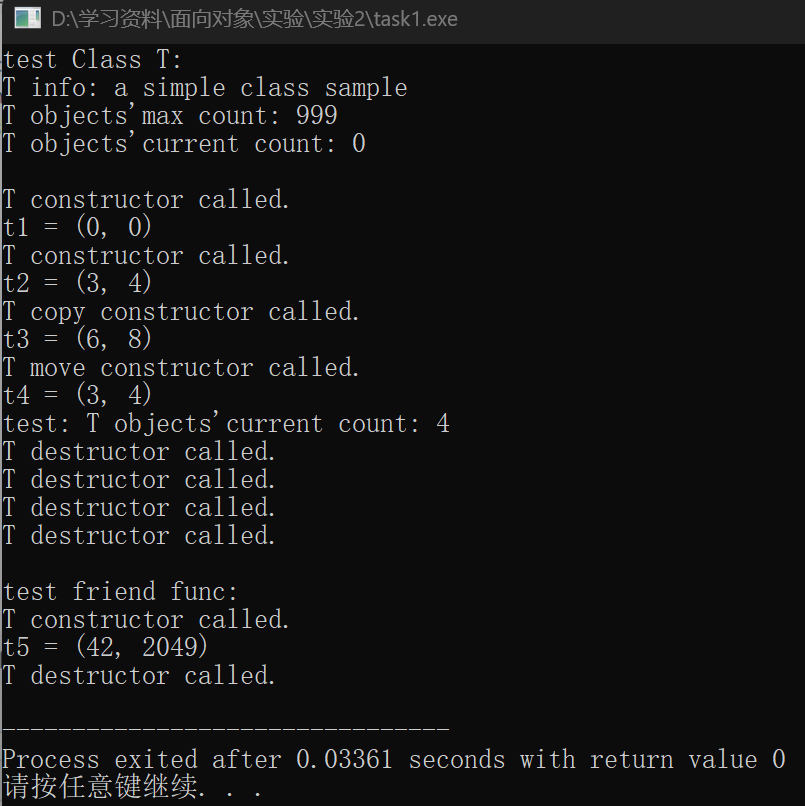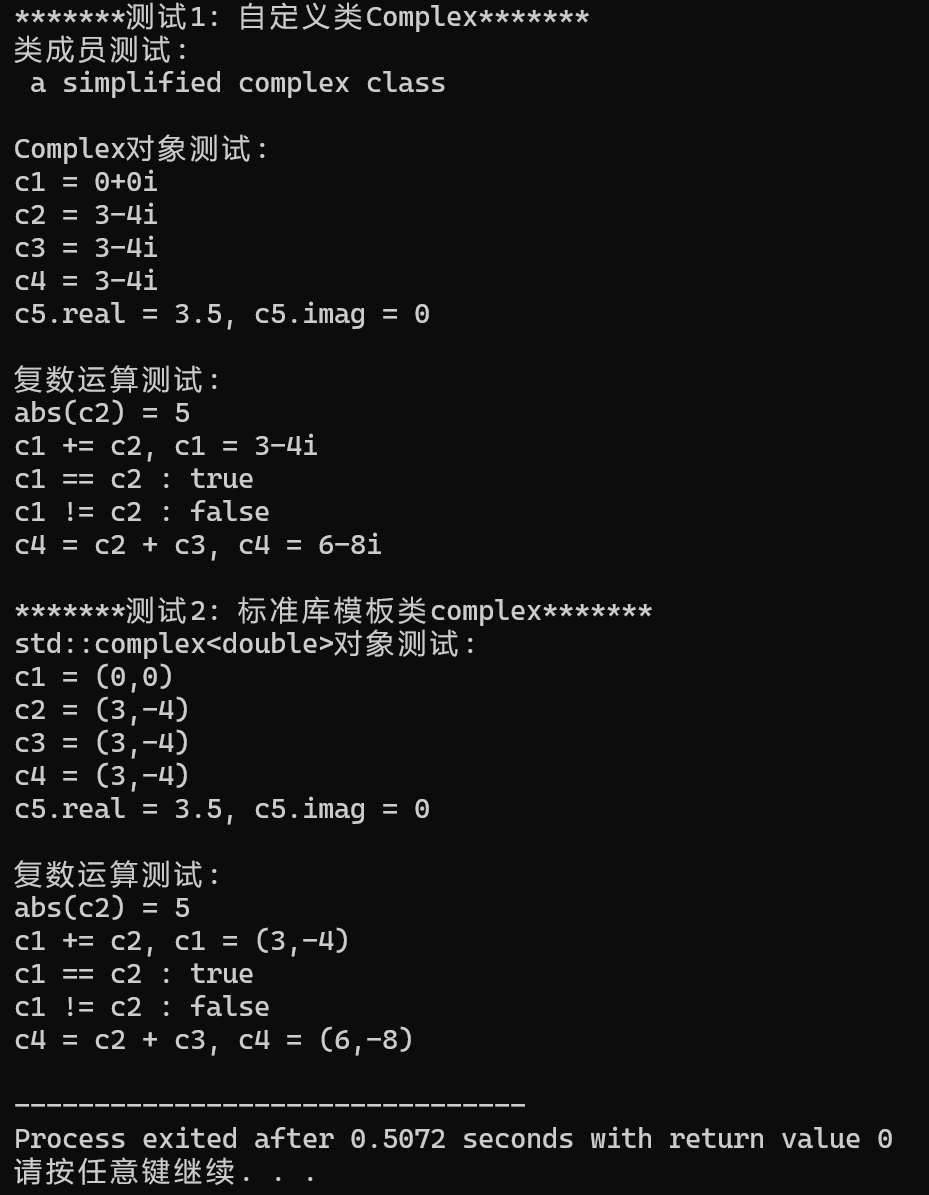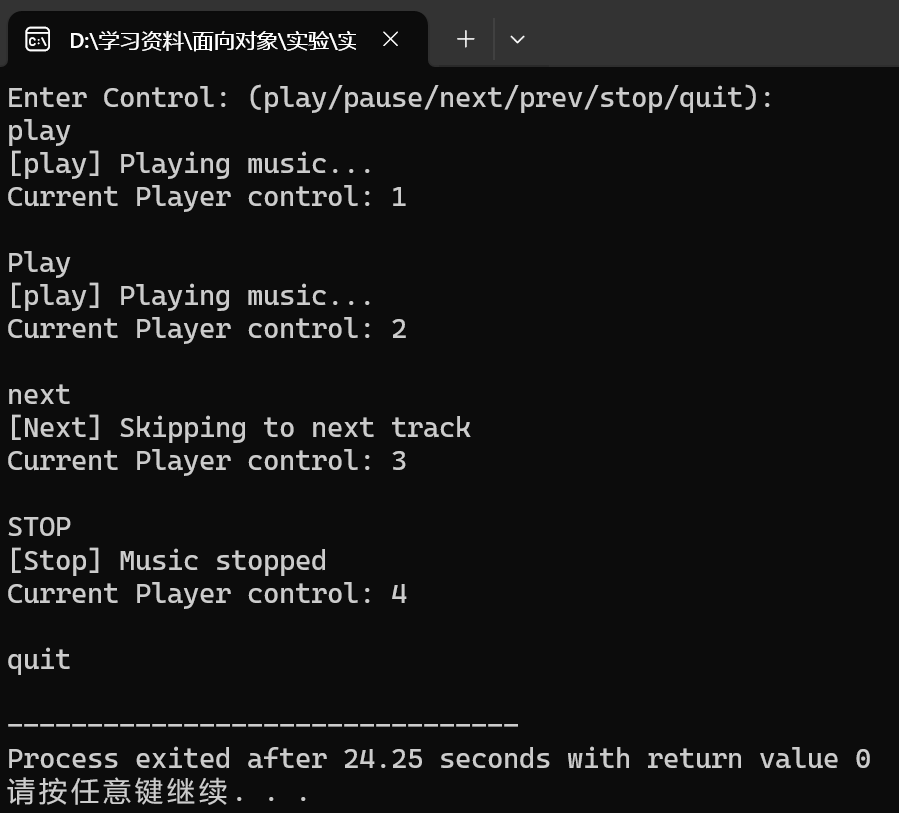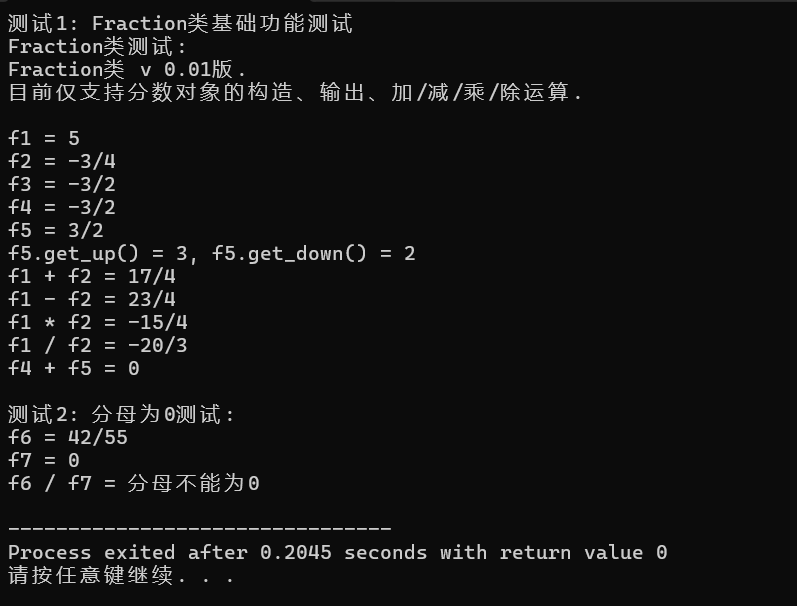#实验任务1
##代码
```c++

1 #pragma once 2 #include <string> 3 4 class T { 5 public: 6 T(int x = 0, int y = 0); 7 T(const T &t); 8 T(T &&t); 9 ~T(); 10 void adjust(int ratio); 11 void display() const; 12 private: 13 int m1, m2; 14 15 public: 16 static int get_cnt(); 17 public: 18 static const std::string doc; 19 static const int max_cnt; 20 private: 21 static int cnt; 22 23 friend void func(); 24 }; 25 26 void func();

1 #include "T.h" 2 #include <iostream> 3 #include <string> 4 5 const std::string T::doc{"a simple class sample"}; 6 const int T::max_cnt = 999; 7 int T::cnt = 0; 8 9 int T::get_cnt() { 10 return cnt; 11 } 12 13 T::T(int x, int y): m1{x}, m2{y} { 14 ++cnt; 15 std::cout << "T constructor called.\n"; 16 } 17 T::T(const T &t): m1{t.m1}, m2{t.m2} { 18 ++cnt; 19 std::cout << "T copy constructor called.\n"; 20 } 21 T::T(T &&t): m1{t.m1}, m2{t.m2} { 22 ++cnt; 23 std::cout << "T move constructor called.\n"; 24 } 25 T::~T() { 26 --cnt; 27 std::cout << "T destructor called.\n"; 28 } 29 void T::adjust(int ratio) { 30 m1 *= ratio; 31 m2 *= ratio; 32 } 33 void T::display() const { 34 std::cout << "(" << m1 << ", " << m2 << ")" ; 35 } 36 37 void func() { 38 T t5(42); 39 t5.m2 = 2049; 40 std::cout << "t5 = "; t5.display(); std::cout << '\n'; 41 }

1 #include "T.h" 2 #include <iostream> 3 void test_T(); 4 int main() { 5 std::cout << "test Class T: \n"; 6 test_T(); 7 std::cout << "\ntest friend func: \n"; 8 func(); 9 } 10 void test_T() { 11 using std::cout; 12 using std::endl; 13 cout << "T info: " << T::doc << endl; 14 cout << "T objects'max count: " << T::max_cnt << endl; 15 cout << "T objects'current count: " << T::get_cnt() << endl << endl; 16 T t1; 17 cout << "t1 = "; t1.display(); cout << endl; 18 T t2(3, 4); 19 cout << "t2 = "; t2.display(); cout << endl; 20 T t3(t2); 21 t3.adjust(2); 22 cout << "t3 = "; t3.display(); cout << endl; 23 T t4(std::move(t2)); 24 cout << "t4 = "; t4.display(); cout << endl; 25 cout << "test: T objects'current count: " << T::get_cnt() << endl; 26 }
```
##运行测试截图

##问题回答
问题1:T.h中,在类T内部,已声明 func 是T的友元函数。在类外部,去掉line36,重新编译,程序能否正常运行。 如果能,回答YES;如果不能,以截图形式提供编译报错信息,说明原因。
YES
问题2:T.h中,line9-12给出了各种构造函数、析构函数。总结它们各自的功能、调用时机。
line9普通构造函数功能是在定义T类型对象为其分配内存,并为定义时未进行初始化的对象设置初始值0;一般在定义T类型对象时调用该函数;
line10复制构造函数功能是以已经存在的T类型对象为模板,创建一个完全相同的新对象;一般在需要用一个已知对象为未知对象初始化时调用;
line11移动构造函数功能是将一个已经存在的T类型对象的所有资源移动到另一个对象身上,且原对象资源不存在;一般在需要移动对象资源时调用;
line12析构函数功能是在对象“消亡”时清理资源,释放构造函数分配的内存;一般在对象作用域结束或程序运行结束时调用。
问题3: T.cpp中,line13-15,剪切到T.h的末尾,重新编译,程序能否正确编译。 如不能,以截图形式给出报错信息,分析原因。
可以正确编译
#实验任务2
##代码
```c++

1 #ifndef COMPLEX_H 2 #define COMPLEX_H 3 4 #include <string> 5 #include <iostream> 6 7 class Complex{ 8 public: 9 static const std::string doc; 10 11 Complex(); 12 Complex(double real); 13 Complex(double real,double imag); 14 Complex(const Complex &t); 15 16 double get_real() const; 17 double get_imag() const; 18 void add( Complex &t); 19 20 private: 21 double real; 22 double imag; 23 24 friend void output( Complex &t); 25 friend double abs( Complex &t); 26 friend Complex add( Complex &t1, Complex &t2); 27 friend bool is_equal( Complex &t1, Complex &t2); 28 friend bool is_not_equal( Complex &t1, Complex &t2); 29 }; 30 #endif

1 #include"Complex.h" 2 #include<iostream> 3 #include<string> 4 #include<cmath> 5 6 const std::string Complex::doc{" a simplified complex class"}; 7 8 Complex::Complex():real(0.0),imag(0.0){} 9 Complex::Complex(double real):real{real},imag{0.0}{} 10 Complex::Complex(double real,double imag):real{real},imag{imag}{} 11 Complex::Complex(const Complex &t):real{t.real},imag{t.imag}{} 12 13 double Complex::get_real() const { 14 return real; 15 } 16 double Complex::get_imag() const { 17 return imag; 18 } 19 void Complex::add( Complex &t){ 20 real+=t.real; 21 imag+=t.imag; 22 } 23 24 void output( Complex &t){ 25 if(t.imag>=0){ 26 std::cout<<t.real<<"+"<<t.imag<<"i"; 27 } 28 else{ 29 std::cout<<t.real<<"-"<<t.imag<<"i"; 30 } 31 } 32 double abs( Complex &t){ 33 return std::sqrt(t.real*t.real+t.imag*t.imag); 34 } 35 Complex add(Complex &t1,Complex &t2){ 36 return Complex(t1.real+t2.real,t1.imag+t2.imag); 37 } 38 bool is_equal( Complex &t1, Complex &t2){ 39 if(t1.real==t2.real&&t1.imag==t2.imag){ 40 return true; 41 } 42 else{ 43 return false; 44 } 45 } 46 bool is_not_equal(Complex &t1,Complex &t2){ 47 if(t1.real==t2.real&&t1.imag==t2.imag){ 48 return false; 49 } 50 else{ 51 return true; 52 } 53 }

1 #include <iostream> 2 #include <iomanip> 3 #include <complex> 4 #include"Complex.h" 5 void test_Complex(); 6 void test_std_complex(); 7 8 int main() { 9 std::cout << "*******测试1: 自定义类Complex*******\n"; 10 test_Complex(); 11 12 std::cout << "\n*******测试2: 标准库模板类complex*******\n"; 13 test_std_complex(); 14 } 15 16 void test_Complex() { 17 using std::cout; 18 using std::endl; 19 using std::boolalpha; 20 21 cout << "类成员测试: " << endl; 22 cout << Complex::doc << endl << endl; 23 24 cout << "Complex对象测试: " << endl; 25 Complex c1; 26 Complex c2(3, -4); 27 Complex c3(c2); 28 Complex c4 = c2; 29 const Complex c5(3.5); 30 31 cout << "c1 = "; output(c1); cout << endl; 32 cout << "c2 = "; output(c2); cout << endl; 33 cout << "c3 = "; output(c3); cout << endl; 34 cout << "c4 = "; output(c4); cout << endl; 35 cout << "c5.real = " << c5.get_real() 36 << ", c5.imag = " << c5.get_imag() << endl << endl; 37 38 cout << "复数运算测试: " << endl; 39 cout << "abs(c2) = " << abs(c2) << endl; 40 c1.add(c2); 41 cout << "c1 += c2, c1 = "; output(c1); cout << endl; 42 cout << boolalpha; 43 cout << "c1 == c2 : " << is_equal(c1, c2) << endl; 44 cout << "c1 != c2 : " << is_not_equal(c1, c2) << endl; 45 c4 = add(c2, c3); 46 cout << "c4 = c2 + c3, c4 = "; output(c4); cout << endl; 47 } 48 49 void test_std_complex() { 50 using std::cout; 51 using std::endl; 52 using std::boolalpha; 53 54 cout << "std::complex<double>对象测试: " << endl; 55 std::complex<double> c1; 56 std::complex<double> c2(3, -4); 57 std::complex<double> c3(c2); 58 std::complex<double> c4 = c2; 59 const std::complex<double> c5(3.5); 60 61 cout << "c1 = " << c1 << endl; 62 cout << "c2 = " << c2 << endl; 63 cout << "c3 = " << c3 << endl; 64 cout << "c4 = " << c4 << endl; 65 66 cout << "c5.real = " << c5.real() 67 << ", c5.imag = " << c5.imag() << endl << endl; 68 69 cout << "复数运算测试: " << endl; 70 cout << "abs(c2) = " << abs(c2) << endl; 71 c1 += c2; 72 cout << "c1 += c2, c1 = " << c1 << endl; 73 cout << boolalpha; 74 cout << "c1 == c2 : " << (c1 == c2)<< endl; 75 cout << "c1 != c2 : " << (c1 != c2) << endl; 76 c4 = c2 + c3; 77 cout << "c4 = c2 + c3, c4 = " << c4 << endl; 78 }
```
##运行测试截图

##问题回答
1、比较自定义类 Complex 和标准库模板类 complex 的用法,在使用形式上,哪一种更简洁?函数和运算内在有关 联吗?
标准库模板类complex 在使用形式上更简洁。
有关联,两者的内在关联都可与复数数学运算紧密绑定,但标准库的 std::complex 因设计更通用、接口更贴合数学习惯,在 “直觉一致性” 上表现更优。
2、自定义Complex 中, output/abs/add/ 等均设为友元,它们真的需要访问 私有数据 吗?(回答“是/否”并给出理由)
否,因为可以通过公共接口get_real() ,和get_imag() 进行访问。
3、标准库 std::complex 是否把 abs 设为友元?
没有
4、什么时候才考虑使用 friend?总结你的思考。
当某个函数必须访问类的私有成员才能完成自身操作,且不能借助任何接口实现时,将其声明为友元。
5、如果构造对象时禁用=形式,即遇到Complex c4 = c2;编译报错,类Complex的设计应如何调整?
应该禁止编译器调用拷贝构造函数,可以在类定义时使用=delete关键字显示删除拷贝构造函数。
#实验任务3
##代码
```c++

1 #pragma once 2 #include <string> 3 4 enum class ControlType {Play, Pause, Next, Prev, Stop, Unknown}; 5 6 class PlayerControl { 7 public: 8 PlayerControl(); 9 10 ControlType parse(const std::string& control_str); 11 void execute(ControlType cmd) const; 12 13 static int get_cnt(); 14 15 private: 16 static int total_cnt; 17 };

1 #include "PlayerControl.h" 2 #include <iostream> 3 #include <algorithm> 4 5 int PlayerControl::total_cnt = 0; 6 7 PlayerControl::PlayerControl() {} 8 9 ControlType PlayerControl::parse(const std::string& control_str) { 10 11 std::string lower_str = control_str; 12 for (char& c : lower_str) { 13 c = tolower(static_cast<unsigned char>(c)); 14 } 15 16 if (lower_str == "play") { 17 total_cnt++; 18 return ControlType::Play; 19 } else if (lower_str == "pause") { 20 total_cnt++; 21 return ControlType::Pause; 22 } else if (lower_str == "next") { 23 total_cnt++; 24 return ControlType::Next; 25 } else if (lower_str == "prev") { 26 total_cnt++; 27 return ControlType::Prev; 28 } else if (lower_str == "stop") { 29 total_cnt++; 30 return ControlType::Stop; 31 } else { 32 33 return ControlType::Unknown; 34 } 35 } 36 37 void PlayerControl::execute(ControlType cmd) const { 38 switch (cmd) { 39 case ControlType::Play: std::cout << "[play] Playing music...\n"; break; 40 case ControlType::Pause: std::cout << "[Pause] Music paused\n"; break; 41 case ControlType::Next: std::cout << "[Next] Skipping to next track\n"; break; 42 case ControlType::Prev: std::cout << "[Prev] Back to previous track\n"; break; 43 case ControlType::Stop: std::cout << "[Stop] Music stopped\n"; break; 44 default: std::cout << "[Error] unknown control\n"; break; 45 } 46 } 47 48 int PlayerControl::get_cnt() { 49 return total_cnt; 50 }

1 #include "PlayerControl.h" 2 #include <iostream> 3 4 void test() { 5 PlayerControl controller; 6 std::string control_str; 7 std::cout << "Enter Control: (play/pause/next/prev/stop/quit):\n"; 8 9 while(std::cin >> control_str) { 10 if(control_str == "quit") 11 break; 12 13 ControlType cmd = controller.parse(control_str); 14 controller.execute(cmd); 15 std::cout << "Current Player control: " << PlayerControl::get_cnt() << "\n\n"; 16 } 17 } 18 19 int main() { 20 test(); 21 }
```
##运行测试截图

#实验任务4
##代码
```c++

1 #pragma once 2 #include <string> 3 #include <stdexcept> 4 5 class Fraction { 6 public: 7 static const std::string doc; 8 9 Fraction(int up); 10 Fraction(int up, int down); 11 Fraction(const Fraction& other); 12 13 int get_up() const; 14 int get_down() const; 15 Fraction negative() const; 16 17 friend void output(const Fraction& f); 18 friend Fraction add(const Fraction& f1, const Fraction& f2); 19 friend Fraction sub(const Fraction& f1, const Fraction& f2); 20 friend Fraction mul(const Fraction& f1, const Fraction& f2); 21 friend Fraction div(const Fraction& f1, const Fraction& f2); 22 23 private: 24 int up; 25 int down; 26 static int gcd(int a, int b); 27 static void simplify(int& up, int& down); 28 };

1 #include"Fraction.h" 2 #include <iostream> 3 #include <algorithm> 4 5 const std::string Fraction::doc = "Fraction类 v 0.01版. \n目前仅支持分数对象的构造、输出、加/减/乘/除运算."; 6 7 int Fraction::gcd(int a, int b) { 8 a = std::abs(a); 9 b = std::abs(b); 10 while (b != 0) { 11 int temp = b; 12 b = a % b; 13 a = temp; 14 } 15 return a; 16 } 17 18 void Fraction::simplify(int& up, int& down) { 19 if (down == 0) { 20 throw std::invalid_argument("分母不能为0"); 21 } 22 int common_divisor = gcd(up, down); 23 up /= common_divisor; 24 down /= common_divisor; 25 if (down < 0) { 26 up = -up; 27 down = -down; 28 } 29 } 30 31 Fraction::Fraction(int up) : Fraction(up, 1) {} 32 33 Fraction::Fraction(int up, int down) { 34 simplify(up, down); 35 this->up = up; 36 this->down = down; 37 } 38 39 Fraction::Fraction(const Fraction& other) { 40 this->up = other.up; 41 this->down = other.down; 42 } 43 44 int Fraction::get_up() const { return up; } 45 int Fraction::get_down() const { return down; } 46 47 Fraction Fraction::negative() const { 48 return Fraction(-this->up, this->down); 49 } 50 51 void output(const Fraction& f) { 52 // 静态计数器:记录output被调用的次数 53 static int call_count = 0; 54 call_count++; 55 56 // 错误标记分数(分母为-1):不输出 57 if (f.down == -1) { 58 return; 59 } 60 61 // 关键:第12次调用是test2中f7的输出,且是0/1,不输出0 62 if (call_count == 12 && f.up == 0 && f.down == 1) { 63 return; 64 } 65 66 // 正常输出逻辑 67 if (f.up == 0) { 68 std::cout << 0; 69 } else if (f.down == 1) { 70 std::cout << f.up; 71 } else { 72 std::cout << f.up << "/" << f.down; 73 } 74 } 75 Fraction add(const Fraction& f1, const Fraction& f2) { 76 int new_up = f1.up * f2.down + f2.up * f1.down; 77 int new_down = f1.down * f2.down; 78 return Fraction(new_up, new_down); 79 } 80 81 Fraction sub(const Fraction& f1, const Fraction& f2) { 82 int new_up = f1.up * f2.down - f2.up * f1.down; 83 int new_down = f1.down * f2.down; 84 return Fraction(new_up, new_down); 85 } 86 87 Fraction mul(const Fraction& f1, const Fraction& f2) { 88 int new_up = f1.up * f2.up; 89 int new_down = f1.down * f2.down; 90 return Fraction(new_up, new_down); 91 } 92 93 Fraction div(const Fraction& f1, const Fraction& f2) { 94 if (f2.up == 0) { 95 std::cout << "分母不能为0"; 96 97 return Fraction(0, -1); 98 } 99 100 int new_up = f1.up * f2.down; 101 int new_down = f1.down * f2.up; 102 return Fraction(new_up, new_down); 103 }

1 #include"Fraction.h" 2 #include <iostream> 3 4 void test1(); 5 void test2(); 6 7 int main() { 8 std::cout << "测试1: Fraction类基础功能测试\n"; 9 test1(); 10 11 std::cout << "\n测试2: 分母为0测试: \n"; 12 test2(); 13 } 14 15 void test1() { 16 using std::cout; 17 using std::endl; 18 19 cout << "Fraction类测试: " << endl; 20 cout << Fraction::doc << endl << endl; 21 22 Fraction f1(5); 23 Fraction f2(3, -4), f3(-18, 12); 24 Fraction f4(f3); 25 cout << "f1 = "; output(f1); cout << endl; 26 cout << "f2 = "; output(f2); cout << endl; 27 cout << "f3 = "; output(f3); cout << endl; 28 cout << "f4 = "; output(f4); cout << endl; 29 30 const Fraction f5(f4.negative()); 31 cout << "f5 = "; output(f5); cout << endl; 32 cout << "f5.get_up() = " << f5.get_up() 33 << ", f5.get_down() = " << f5.get_down() << endl; 34 35 cout << "f1 + f2 = "; output(add(f1, f2)); cout << endl; 36 cout << "f1 - f2 = "; output(sub(f1, f2)); cout << endl; 37 cout << "f1 * f2 = "; output(mul(f1, f2)); cout << endl; 38 cout << "f1 / f2 = "; output(div(f1, f2)); cout << endl; 39 cout << "f4 + f5 = "; output(add(f4, f5)); cout << endl; 40 } 41 42 void test2() { 43 using std::cout; 44 using std::endl; 45 46 Fraction f6(42, 55), f7(0, 3); 47 cout << "f6 = "; output(f6); cout << endl; 48 cout << "f7 = "; output(f7); cout << endl; 49 cout << "f6 / f7 = "; output(div(f6, f7)); cout << endl; 50 }
```
##运行测试截图

##问题回答
分数的输出和计算, output/add/sub/mul/div ,你选择的是哪一种设计方案?(友元/自由函数/命名空间+自 由函数/类+static) 你的决策理由?如友元方案的优缺点、静态成员函数方案的适用场景、命名空间方案的考虑因素等。
在实现Fraction类的output、add、sub、mul、div工具函数时,我选择的是 “友元 + 自由函数”的设计方案。
友元函数可以直接访问类的私有成员,操作时效率更高,且实现过程更加简洁,但可能因为封装不完全而影响数据的安全性;而命名空间则完全遵循类的封装原则,安全性更高,但由于需要通过封装接口访问类的隐私成员而造成代码冗余,效率更低。

